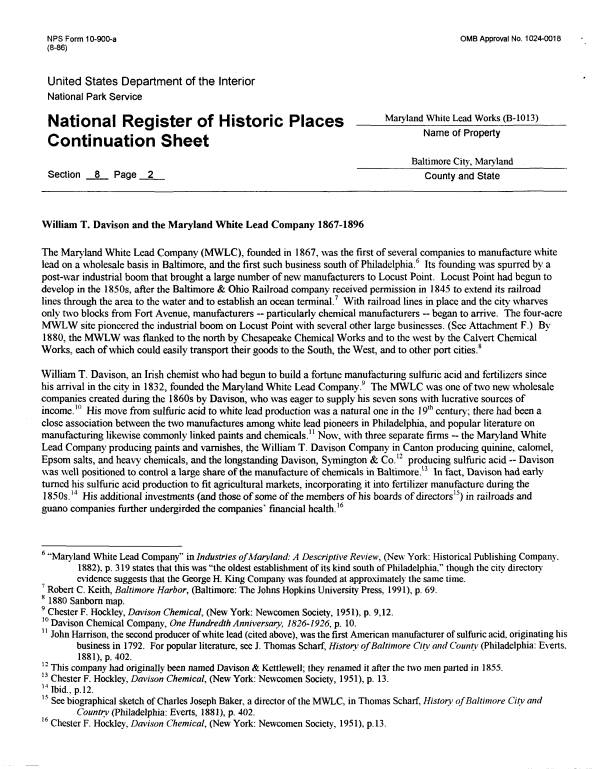 |
||||
|
DEPARTMENT OF HOUSING AND COMMUNITY DEVELOPMENT, MARYLAND HISTORICAL TRUST (Historic Sites Survey) var.d. MSA SE16-2 Image No: se16-2-0010 Enlarge and print image (86K) |
 |
||||
|
DEPARTMENT OF HOUSING AND COMMUNITY DEVELOPMENT, MARYLAND HISTORICAL TRUST (Historic Sites Survey) var.d. MSA SE16-2 Image No: se16-2-0010 Enlarge and print image (86K) |
| N PS Form 10-900-a OMB Approval No. 1024-0018 (8-86) United States Department of the Interior National Park Service National Register of Historic Places MarylandmiteLead Works(B-1013) n .. t_. f** . Name of Property Continuation Sheet Baltimore City, Maryland Section 8 Page 2 County and State William T. Davison and the Maryland White Lead Company 1867-1896 The Maryland White Lead Company (MWLC), founded in 1867, was the first of several companies to manufacture white lead on a wholesale basis in Baltimore, and the first such business south of Philadelphia.6 Its founding was spurred by a post-war industrial boom that brought a large number of new manufacturers to Locust Point. Locust Point had begun to develop in the 1850s, after the Baltimore & Ohio Railroad company received permission in 1845 to extend its railroad lines through the area to the water and to establish an ocean terminal.7 With railroad lines in place and the city wharves only two blocks from Fort Avenue, manufacturers — particularly chemical manufacturers — began to arrive. The four-acre MWLW site pioneered the industrial boom on Locust Point with several other large businesses. (See Attachment F.) By 1880, the MWLW was flanked to the north by Chesapeake Chemical Works and to the west by the Calvert Chemical Works, each of which could easily transport their goods to the South, the West, and to other port cities.8 William T. Davison, an Irish chemist who had begun to build a fortune manufacturing sulfiinc acid and fertilizers since his arrival in the city in 1832, founded the Maryland White Lead Company.9 The MWLC was one of two new wholesale companies created during the 1860s by Davison, who was eager to supply his seven sons with lucrative sources of income.10 His move from sulfuric acid to white lead production was a natural one in the 19th century; there had been a close association between the two manufactures among white lead pioneers in Philadelphia, and popular literature on manufacturing likewise commonly linked paints and chemicals.11 Now, with three separate firms — the Maryland White Lead Company producing paints and varnishes, the William T. Davison Company in Canton producing quinine, calomel, Epsom salts, and heavy chemicals, and the longstanding Davison, Symington & Co.12 producing sulfuric acid -- Davison was well positioned to control a large share of the manufacture of chemicals in Baltimore.13 In fact, Davison had early turned his sulfuric acid production to fit agricultural markets, incorporating it into fertilizer manufacture during the 1850s.14 His additional investments (and those of some of the members of his boards of directors15) in railroads and guano companies further undergirded the companies' financial health.16 6 "Maryland White Lead Company" in Industries of Maryland: A Descriptive Review, (New York: Historical Publishing Company, 1882), p. 319 states that this was "the oldest establishment of its kind south of Philadelphia." though the city directory evidence suggests that the George H. King Company was founded at approximately the same time. 7 Robert C. Keith, Baltimore Harbor, (Baltimore: The Johns Hopkins University Press, 1991), p. 69. 8 1880 Sanborn map. 9 Chester F. Hockley, Davison Chemical, (New York: Newcomen Society, 1951), p. 9,12. 10 Davison Chemical Company, One Hundredth Anniversary, 1826-1926, p. 10. 11 John Harrison, the second producer of white lead (cited above), was the first American manufacturer of sulfuric acid, originating his business in 1792. For popular literature, see J. Thomas Scharf, History- of Baltimore City and County (Philadelphia: Everts. 1881), p. 402. 12 This company had originally been named Davison & Kettlewell; they renamed it after the two men parted in 1855. 13 Chester F. Hockley, Davison Chemical, (New York: Newcomen Society, 1951), p. 13. 14 Ibid., p. 12. 15 See biographical sketch of Charles Joseph Baker, a director of the MWLC, in Thomas Scharf, History of Baltimore City and Country (Philadelphia: Everts, 1881), p. 402. 16 Chester F. Hockley, Davison Chemical, (New York: Newcomen Society, 1951), p.13. |